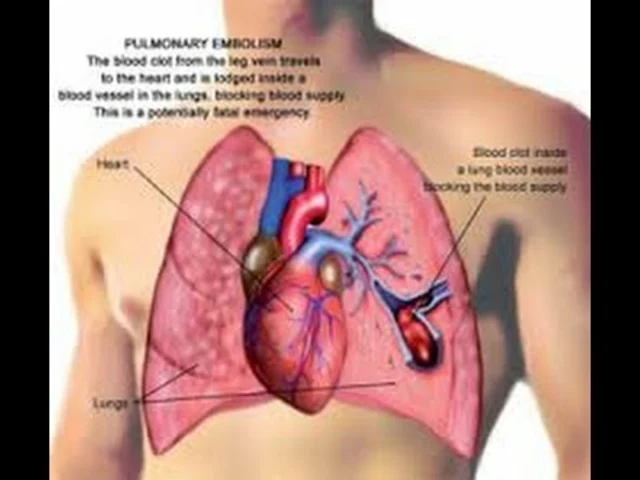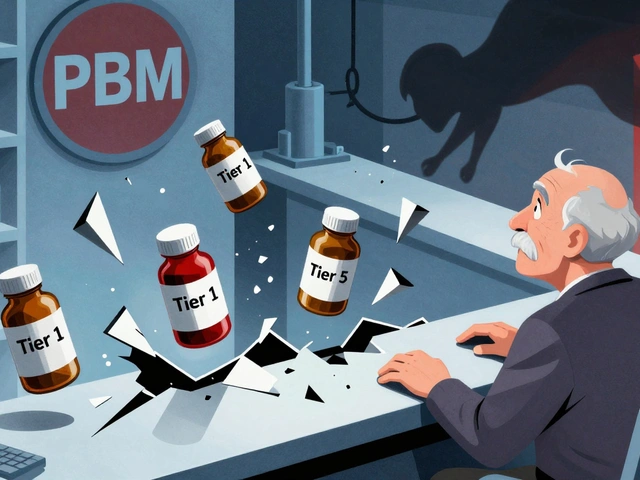Entering into the World of Medication: Fenticonazole
Once upon a time, I was a man blissfully unaware of the medical jargon. Words like Fenticonazole were completely foreign to me, and medication, in general, was something I only involved myself with when I had a runny nose or occasional headache. But the universe has a funny way of throwing curveballs at us, and mine came in the form of a fungal infection that required an introduction to this unfamiliar medication.
And before I forget, for those who are in the dark like I once was, Fenticonazole is an imidazole antifungal drug, often used for topical treatment of vulvovaginal candidiasis. And yes, I too found it strange that a medicine commonly used for a female health issue was being administered to a man! It's science, folks. Always full of surprises.
The Surprise Diagnosis: How I Met Fenticonazole
It was during a family holiday. We were at the beach when I noticed an unusual rash. Thinking nothing of it, I dismissed it as mere sunburn. But as the days passed, the rash persisted and I began to feel uncomfortable. You know, the kind of discomfort that makes you squirm around in your chair when you're trying to enjoy your favorite TV show? Yeah, that kind.
After a couple of embarrassed confessions about my condition to my partner and some persuasion, I decided to swallow my male pride and pay the doctor a visit. There, after a brief, albeit rather uncomfortable examination, I was hit with the diagnosis: a fungal infection. "Skin candidiasis," the doctor called it, and that's how I found myself being introduced to Fenticonazole.
The First Encounter: A Man and his Medication
Bearing in mind my general naivety about medications, the first application of Fenticonazole felt...interesting. On one hand, there was the excited curiosity of a child trying a new toy. On the other hand, there was the gnawing anxiety of an adult scared at the potential side effects. Despite every reassurance, the mind does tend to wander into the 'what if' territory. Take it from a man whose imagination can run wilder than his kids, Leon and Odette playing superheroes in the backyard.
But, a few applications in, and much to my relief, the Fenticonazole treatment turned out to be much less threatening than initially perceived. Side effects were minimal, and its efficacy shone through quite promptly.
The Unexpected Side-Effects
While my overall experience was mostly positive, Fenticonazole and I did have few interesting skirmishes. Those with sensitivities, beware! In my case, the area affected by the skin candidiasis became surprisingly tender after around the third application. It wasn't intolerable, but definitely worth mentioning.
There was also a slight sensation of warmth upon applying the cream, which though unsettling, was brief. And one other thing - when applying the Fenticonazole, remember to be careful with your clothing choices. Certain fabrics can become bleached - so stay clear of your favorite clothes until the treatment course is complete.
The Healing Journey: In Defense of Fenticonazole
Fenticonazole, in my experience, was pretty effective. Despite the slight sensitivity issues, it delivered results fairly quickly. The constant itching I'd been plagued with started to dissipate, as did the redness and discomfort. I resumed living my life as normal, and before I knew it, those minor setbacks shrank into insignificance. Frankly, I was more preoccupied about whether I'd make it through a whole day without spilling my coffee!
All I can say is, when one is suffering from an infection like skin candidiasis, the last thing you want to worry about is whether the medication you're using is going to work. And thankfully, with Fenticonazole, that worry was soon eased aside.
Lessons Learned: The Educated Patient
Truthfully, during my Fenticonazole experience, I learned more about the world of medication and personal health than I ever expected. Interactions with healthcare professionals, countless internet searches, and first-hand experience with Fenticonazole taught me the importance of staying informed and proactive when it comes to my health.
My tale also illustrates that medication and treatments are not gender-exclusive - far from it. Even the 'manliest' of men can require treatments typically given to females, and vice versa. It's essential we break these misconceptions and stereotypes when it comes to health and medicine.
Final Thoughts: Farewell, but not Forgotten
My personal journey with Fenticonazole has been a transformative one. From a clueless dad fumbling about in the world of medical jargon to an informed patient, my experience taught me invaluable lessons about health and the importance of proper medication.
If you'd told me years ago that I'd be using Fenticonazole for a skin condition, I'd have said you were bonkers! But, life is full of surprises. And now, healthier and happier, I can look back at my Fenticonazole experience with gratitude and just that dash of wry humor it deserves.








13 Comments
Fenticonazole works bettr than most creams, just keep it clean.
Watch for skin irritation after a few doses.
One must acknowledge the ethical imperative embedded within pharmacological stewardship; the indiscriminate application of antifungal agents without rigorous patient education constitutes a breach of professional duty. The ontology of gendered medication is a social construct, not a pharmacodynamic reality, and persisting in such reductive binaries undermines the epistemic foundations of modern therapeutics. Moreover, the commodification of Fenticonazole within a neoliberal market framework precipitates a cascade of externalities that burden both individual patients and the collective biosphere. Systemic oversight mechanisms should be calibrated to detect and rectify off‑label usage that lacks evidentiary support, thereby safeguarding the integrity of clinical guidelines. It is incumbent upon clinicians to articulate the mechanistic pathways of azole derivatives, explicating the inhibition of lanosterol 14α‑demethylase and its downstream effects on ergosterol synthesis. Failure to do so may propagate misconceptions about drug efficacy and safety profiles. The case narrative presented exemplifies a commendable patient‑centered outcome; however, it also illustrates the latent risk of dermal bleaching phenomena associated with formulation excipients. Comprehensive risk–benefit analyses must be undertaken prior to prescription, especially when patients possess dermatological sensitivities. Institutional review boards should integrate patient‑reported outcome measures (PROMs) to quantify experiential side‑effects, such as warmth or tenderness, which are often relegated to anecdotal status. In the context of health equity, barriers to accessing accurate information-whether linguistic, cultural, or socioeconomic-must be dismantled. Telemedicine platforms, when properly regulated, can serve as vectors for disseminating nuanced pharmacovigilance data. Nonetheless, the reliance on digital self‑diagnosis algorithms without corroborative clinical assessment may exacerbate misinformation cycles. Stakeholders must therefore cultivate a multifaceted approach, intertwining evidence‑based medicine, patient empowerment, and ethical stewardship. By doing so, the medical community can transcend archaic gendered prescriptions and champion a truly inclusive paradigm of care.
Man, I was ready to call in the cavalry when that rash showed up! 🌊 The beach vibes turned into a full‑blown drama series overnight, and I swear the cream felt like fireworks on my skin! 😱 But after a few days the itching calmed down and I could finally enjoy my coffee without wincing. 🎉 Stay strong, folks – the fight is real! 💪
Love that you shared your story – super helpful!
Ah the human condition, ever‑so‑fragile and yet we chase the balm like moths to a flame 😌
One could argue that the tender spot after the third application is but a reminder of our own mortality, a subtle whisper from the epidermis urging mindfulness 😊
But fear not, the warmth you felt is merely the body’s alchemical response to the azole’s potent dance with fungal membranes 🌿
I feel you 😊 it can be scary at first but you’re not alone! The tingling is normal and usually fades fast. Keep an eye on the skin and it’ll get better soon! 🌸
Thank you for this detailed account. From a clinical perspective, it is valuable to note the transient erythema and the bleaching effect on certain fabrics, which are documented but often under‑emphasized in patient education. I would recommend patients avoid synthetic blends during the course and conduct a patch test if they have a history of dermatologic sensitivity. Should any systemic symptoms arise, such as fever or widespread rash, immediate medical evaluation is warranted. Overall, your experience reinforces the efficacy of topical azoles when applied as directed.
Esteemed author, your narrative provides an exemplary case study of topical antifungal therapy. It is commendable that you observed the nuanced side‑effects, such as localized warmth and fabric discoloration, and reported them with candor. Future practitioners would benefit from incorporating your findings into educational modules, emphasizing both efficacy and patient‑centred cautionary measures. May your continued advocacy for informed medication use inspire a broader discourse on gender‑neutral prescribing practices.
Hello there!!! I must say, reading about your experience with Fenticonazole was both enlightening and reassuring!!! It’s fantastic that the medication provided swift relief!!! Remember, if any unexpected reactions occur, do not hesitate to consult your healthcare provider!!! Stay healthy and keep sharing your journey!!!
Thank you for your openness. Your perseverance is admirable, and I’m glad the treatment proved effective. 😊 Remember to monitor the affected area for any lingering sensitivity, and don’t hesitate to reach out to your clinician if you notice new symptoms. 🌟
Nice write‑up! I think it’s key to note that azole antifungals, like Fenticonazole, inhibit the cytochrome P450‑dependent 14α‑demethylase in the fungal cell membrane synthesis pathway. This mechanistic insight helps us explain why topical application can resolve candidal infections quickly. Also, be aware of potential drug‑drug interactions if you’re using systemic meds-though rare with a cream, it’s still good practice to double‑check.
Great job documenting the whole process.
I went through a similar experience once and learned a few things along the way. First, keep the area clean and dry, as moisture can prolong fungal growth. Second, avoid tight clothing that traps heat; breathable fabrics make a big difference. Third, if you notice any worsening redness or swelling after the third application, it might be a sign of an allergic response, so pause and consult your doctor. Lastly, patience is key-most topical treatments need consistent use for several days before you see visible improvement. Hang in there, recovery is on the horizon.
Your story highlights several practical tips that can aid others dealing with skin candidiasis. It’s important to emphasize the role of proper hygiene, regular application intervals, and the avoidance of irritants such as harsh detergents. Additionally, monitoring for signs of secondary infection-like increasing pain, pus, or fever-should prompt immediate medical attention. By sharing these insights, you contribute valuable peer‑to‑peer knowledge that complements professional guidance.